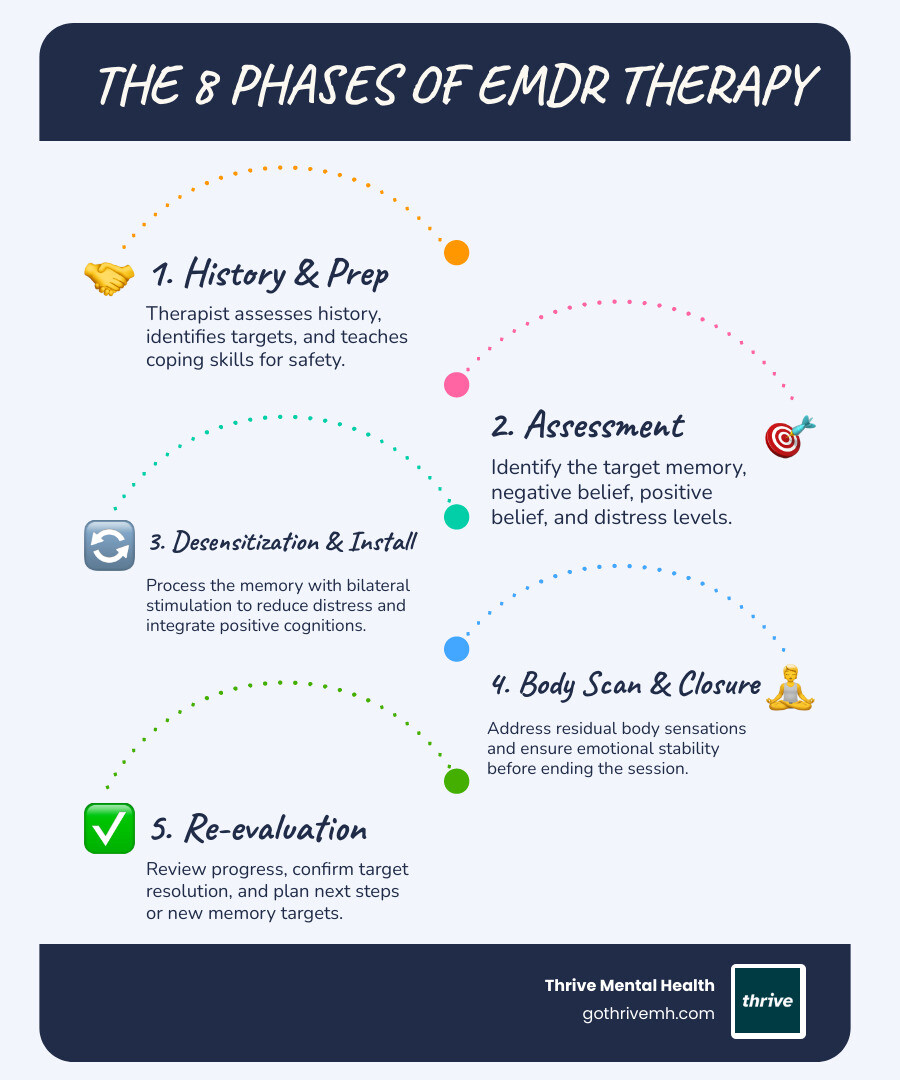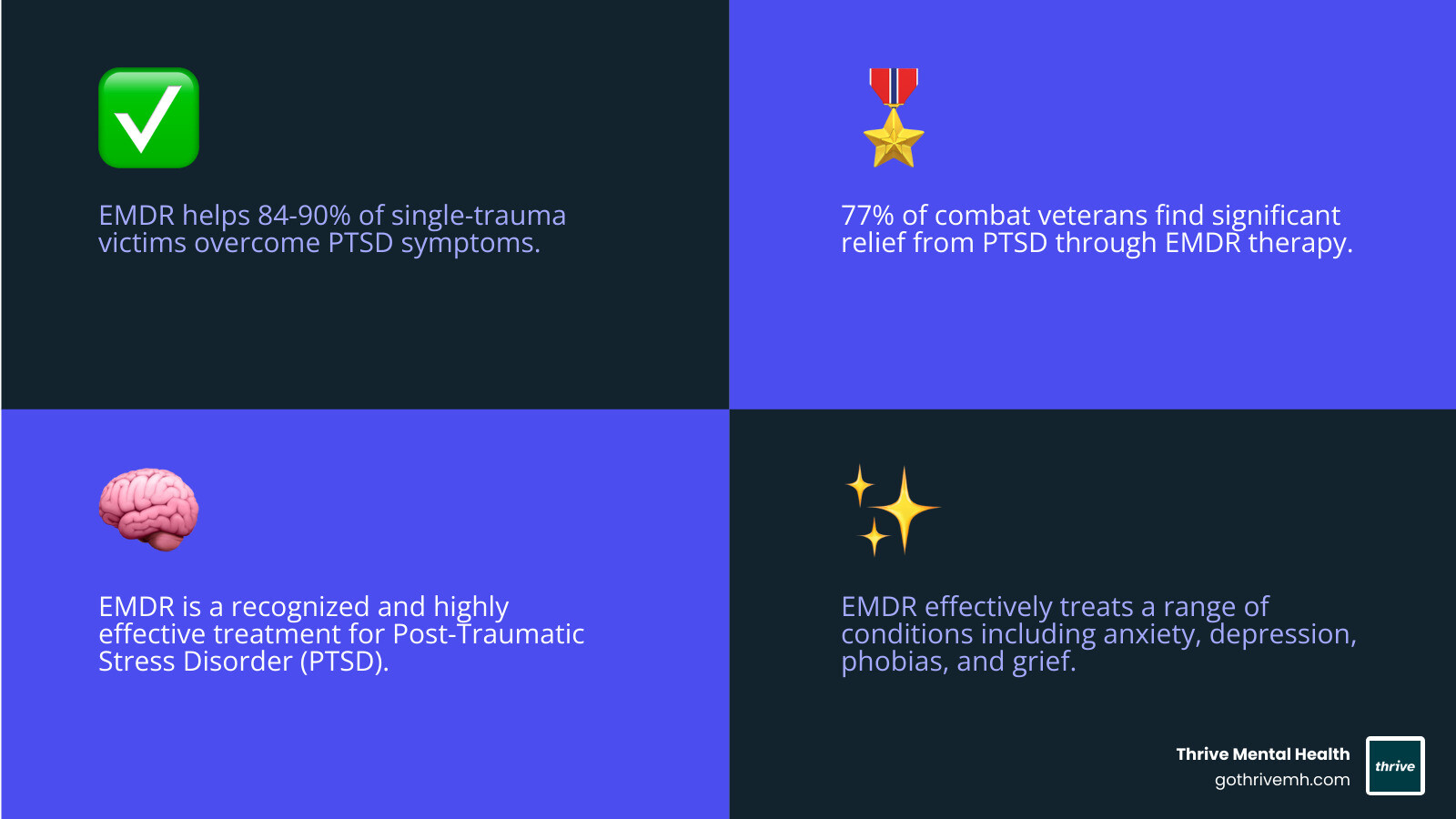Beyond the Buzz: Demystifying EMDR Therapy

What is EMDR and how does it work: 8 Powerful Phases
Opening Your Brain’s Natural Healing Power
Eye Movement Desensitization and Reprocessing (EMDR) is a structured psychotherapy that helps people heal from trauma. It uses bilateral stimulation—like guided eye movements—to help the brain reprocess distressing memories, reducing their emotional impact and helping you move forward.
Quick Answer:
- What it is: A therapy using eye movements and other bilateral stimulation to help process trauma.
- How it works: An 8-phase treatment combining memory recall with bilateral stimulation.
- What it treats: PTSD, anxiety, depression, phobias, and other trauma-related issues.
- Success rate: Up to 90% of single-trauma victims no longer have PTSD after just 3 sessions.
- Time needed: 60-90 minute sessions, typically 3-12 sessions depending on the trauma’s complexity.
When a traumatic event occurs, the memory can get “stuck,” causing flashbacks, nightmares, or overwhelming emotions long after. It’s like a physical wound that never healed because the natural healing process was interrupted.
EMDR therapy helps restart that process. Unlike traditional talk therapy, you don’t need to describe your trauma in detail. You focus on the memory while following your therapist’s finger or listening to alternating sounds. This bilateral stimulation helps your brain reprocess the memory so it no longer feels overwhelming.
Research shows remarkable results. Studies found that 84-90% of single-trauma victims no longer had PTSD after just three 90-minute sessions. The World Health Organization recommends EMDR as a first-line treatment for PTSD in children, adolescents, and adults.
As Anna Green, LMHC, LPC, and founder of Thrive Mental Health, I’ve witnessed EMDR’s transformative power. Understanding what is EMDR and how does it work has been crucial in helping countless clients move from trauma to healing.

What is emdr and how does it work vocabulary:
What Is EMDR Therapy? A Closer Look at the Breakthrough Treatment
When you smell a certain scent or hear a specific sound, are you suddenly thrown back into a terrible moment from years ago? If your heart races and you feel like you’re reliving a past event, you’re not alone—and a powerful therapy can help.
EMDR stands for Eye Movement Desensitization and Reprocessing. Developed in 1987 by Dr. Francine Shapiro, it’s a structured psychotherapy designed to alleviate the distress of traumatic memories. She finded that her own disturbing thoughts became less intense when her eyes moved back and forth, a finding that became the basis for EMDR.
The goal is to help your brain finish processing experiences that got “stuck.”
EMDR isn’t just for “big T” traumas like combat or major accidents. It’s also highly effective for “little t” traumas—experiences like public humiliation, a painful breakup, or harsh criticism that leave lasting marks. These events can create patterns of low self-esteem, anxiety, or powerlessness.
Instead of erasing memories, EMDR changes how memories are stored in your brain. It helps a painful, infected wound heal into a scar—it’s still part of your story, but it no longer causes pain.
Major health organizations, including the American Psychiatric Association, the World Health Organization, and the U.S. Department of Veterans Affairs, endorse EMDR as a best practice for PTSD. You can learn more from the American Psychological Association guidelines on EMDR.
For a deeper look, our guide on EMDR for trauma recovery offers more insight.
The Theory: Adaptive Information Processing (AIP)
Understanding what is EMDR and how does it work begins with the Adaptive Information Processing (AIP) model. The theory is simple: your brain has a natural system designed to process information and move you toward mental health.
When something traumatic happens, this system can get overwhelmed. The memory becomes “stuck” or maladaptively stored with all its original intensity—the emotions, physical sensations, and sounds. This is why a car backfiring can trigger a combat veteran; the brain reacts as if the threat is happening now because the memory was never properly filed away.
The AIP model suggests that symptoms like anxiety, depression, and PTSD often stem from these inadequately processed past experiences. EMDR therapy facilitates the reprocessing of these stuck memories, connecting them with more positive, adaptive information in your brain. This creates an “adaptive resolution”—the memory is re-stored in a way that’s no longer emotionally disturbing.
The Engine: The Role of Bilateral Stimulation (BLS)
The most unique part of EMDR is Bilateral Stimulation (BLS). This is a rhythmic, left-right stimulation that engages both sides of your brain while you focus on a memory.
This can be done in several ways:
- Eye movements: Following a therapist’s finger or a light bar back and forth.
- Auditory tones: Listening to sounds that alternate between left and right ears.
- Tactile tapping: Holding small pulsers that vibrate alternately in each hand.
BLS acts as a “dual-attention stimulus.” Part of your attention is on the memory, while the other part is on the back-and-forth motion. One theory, working memory taxation, suggests this makes it harder to hold onto the memory’s vividness and emotional intensity, creating space for reprocessing.
Another theory is that BLS mimics the eye movements of REM sleep, the stage of sleep where your brain processes daily events and consolidates memories. EMDR may tap into this natural healing mechanism in a focused, therapeutic way, allowing your brain to finally integrate painful memories.
So, What Is EMDR and How Does It Work in Practice?
EMDR is a highly structured, eight-phase psychotherapy designed to guide you safely through processing difficult memories. It’s a collaborative process between you and your therapist, focusing on past events, present triggers, and future goals.
A key feature of EMDR is that it doesn’t require you to describe your trauma in painful detail. Instead, you’ll focus on the internal experience—the images, thoughts, and body sensations—while the therapist guides you through bilateral stimulation. This allows your brain’s natural healing process to take over, making it less intimidating than traditional talk therapy. For more on how this applies to trauma, explore our resources on PTSD treatment.
Phase 1 & 2: Building a Foundation of Safety and Trust
Before any processing begins, your therapist establishes a foundation of safety. In Phase 1 (History-Taking), they’ll learn your story, identify target memories for processing, and create a treatment plan. In Phase 2 (Preparation), you’ll build an emotional toolkit of stress reduction techniques. A key skill is creating a “Safe or Calm Place”—a vivid mental image of a secure place you can return to whenever you feel overwhelmed.
Phase 3-6: The Core Reprocessing Work
This is the heart of EMDR, where stuck memories are processed. In Phase 3 (Assessment), you’ll identify the target memory’s most disturbing image, a related negative belief about yourself (e.g., “I am helpless”), and a positive belief you’d rather have (e.g., “I am safe now”).
In Phase 4 (Desensitization), you’ll hold the memory in mind while engaging in sets of bilateral stimulation. After each set, you’ll report what you notice as the memory’s emotional charge begins to fade. The goal is to reduce your distress to a neutral level.
During Phase 5 (Installation), you’ll focus on strengthening the positive belief until it feels true. Finally, in Phase 6 (Body Scan), you’ll check for any lingering physical tension related to the memory and use more bilateral stimulation to release it.
Phase 7 & 8: Integration and Looking Forward
The final phases ensure your healing is stable and integrated into your daily life. Phase 7 (Closure) happens at the end of every session, using grounding techniques to ensure you leave feeling calm. If a memory is not fully processed, your therapist will help you contain it until the next session. In Phase 8 (Re-evaluation), the beginning of each new session, you’ll review your progress to ensure the positive changes are holding and identify any new areas to address.
Is EMDR Effective? [Stats, Conditions & What to Expect]

When people ask what is EMDR and how does it work, they really want to know: does it actually help? The answer is a resounding yes, backed by decades of research.
While EMDR is best known for treating Post-Traumatic Stress Disorder (PTSD), its effectiveness extends to many other conditions, including:
- Anxiety disorders and panic attacks
- Depression
- Phobias
- Complicated grief
- Dissociative disorders
- Eating disorders
- Chronic pain and addictions
- Performance anxiety
How Effective is EMDR Therapy?
The research behind EMDR is compelling. Studies show that 84%-90% of single-trauma victims no longer meet the criteria for PTSD after just three 90-minute sessions. Another major study found that 100% of single-trauma victims and 77% of multiple-trauma victims were free from PTSD after six 50-minute sessions. For combat veterans, 77% were no longer diagnosed with PTSD after 12 sessions.
These numbers represent real people getting their lives back. The World Health Organization recommendations endorse EMDR as a first-line psychotherapy for PTSD in all age groups. Unlike some other treatments, EMDR often yields rapid results without requiring patients to verbally relive every painful detail. If you’re curious how it compares to other body-based approaches, our guide on Somatic Therapy vs. EMDR: Which is Right for You? offers a clear breakdown.
How Long Does EMDR Therapy Take?
EMDR sessions typically last 60 to 90 minutes, which is slightly longer than standard therapy to allow for complete processing.
- For single, isolated traumas, most people find resolution in 3 to 6 sessions.
- For complex or multiple traumas (like childhood abuse or combat exposure), treatment typically requires 8 to 12+ sessions.
EMDR is an individual therapy with no homework assignments, though your therapist may ask you to track thoughts or feelings that arise between sessions.
Insurance Coverage for EMDR in Florida
Most major insurance providers recognize EMDR as a legitimate, evidence-based treatment. Providers like Cigna, Aetna, Florida Blue, and Optum typically offer coverage. However, benefits vary based on your specific plan.
We always recommend verifying your benefits before starting treatment. Some plans require pre-authorization, and in-network vs. out-of-network coverage can differ substantially. At Thrive Mental Health, our team can help you navigate your insurance coverage in Florida so you can focus on your healing.
Frequently Asked Questions about EMDR Therapy
If you’re considering EMDR, you likely have questions about what the experience is really like. Here are some of the most common concerns we hear.
Do you have to talk about your trauma in detail during EMDR?
No, you do not need to describe the traumatic event in detail. Unlike talk therapy, EMDR works differently. You will be asked to hold certain aspects of the memory in your mind (like an image or feeling), but you are not required to verbally recount the entire experience. This can be a major relief for those who find it difficult or re-traumatizing to talk about what happened.
What are the risks or side effects of EMDR?
EMDR is considered safe when conducted by a trained therapist. The most common side effect is a temporary increase in distressing thoughts or vivid dreams between sessions as your brain continues processing. This is a normal sign that the therapy is working. Your therapist will teach you coping skills (like the “Safe Place” exercise) to manage any discomfort that arises, ensuring you feel supported throughout the process.
How is EMDR different from traditional talk therapy (like CBT)?
While both are effective, EMDR and Cognitive Behavioral Therapy (CBT) work differently. The key distinction is that EMDR uses bilateral stimulation to change how memories are stored, while CBT focuses on analyzing and changing current thought patterns.
| Feature | EMDR Therapy | Traditional CBT |
|---|---|---|
| Primary Method | Uses bilateral stimulation (eye movements, sounds, or taps) while you focus on memories | Focuses on talking through and analyzing thoughts and behaviors |
| Trauma Discussion | Minimal verbal description needed—you process internally | Often requires detailed discussion of traumatic events |
| Changing Beliefs | Helps your brain naturally shift from negative to positive beliefs | Directly challenges and disputes negative thought patterns |
| Memory Work | Brief, interrupted focus on memories with bilateral stimulation | May involve extended exposure to distressing memories |
| Between Sessions | Usually no formal homework assignments | Often includes worksheets, thought records, and practice exercises |
| How Beliefs Change | Your brain naturally reformulates beliefs during processing | You consciously work to change thoughts through reasoning and evidence |
| Speed of Results | Often described as accelerated processing with quicker symptom reduction | More gradual process requiring consistent practice over time |
Start Your Healing Journey with EMDR
Now that you understand what is EMDR and how does it work, you can take the first step toward reclaiming your life from trauma. This scientifically proven pathway helps your brain do what it’s designed to do: heal itself.
EMDR offers a structured, gentle way to reprocess traumatic memories without getting stuck talking about painful details. Many of our clients report feeling lighter, more grounded, and hopeful after just a few sessions.
Taking the first step is an act of strength. At Thrive Mental Health, we make it easier with flexible programs designed for real life. We offer virtual and hybrid Intensive Outpatient Programs (IOP) and Partial Hospitalization Programs (PHP) with evening options. With our services centered in Florida, you can access expert-led EMDR therapy from a place that feels safe for you.
Ready for support? Thrive offers virtual and hybrid IOP/PHP with evening options. Verify your insurance in 2 minutes (no obligation) → Start benefits check or call 561-203-6085. If you’re in crisis, call/text 988.
